dining Arrangement
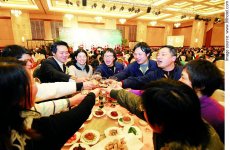 A good friend of mine once observed that some people eat to live, and others live to eat. Many Chinese people, myself included, seem to fall into this second category.
A good friend of mine once observed that some people eat to live, and others live to eat. Many Chinese people, myself included, seem to fall into this second category.
For us, our days revolve around food. After breakfast we think about lunch, and after lunch we plan for dinner. In southern China, there are also dedicated times for morning dim sum treats — zăo chá (早茶) — and guilt-free midnight snacks — yè xiāo (夜宵) .
Food is a central part of Chinese culture. There is great pleasure in sharing meals with family and friends, but there are also important etiquette and table manners, especially in more formal situations.
Chinese formalities around dining are very different, so Westerners who sit down to a delicious meal may sometimes get more than they can chew.
This article walks you through a full Chinese banquet with tips and vocabulary along the way for navigating the dangerous territories of shark fin soup and other dishes.
With this knowledge under your belt, hopefully you can loosen up and enjoy the meal without any worries!
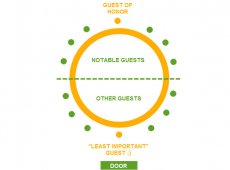 Seating Arrangements
Seating Arrangements
Many restaurants in China offer private dining rooms with large round tables and spinning Lazy Susans.
Seating may not be marked, but don’t be fooled – there are unspoken rules for who sits where.
Generally, the "least important" person of a banquet sits closest to the entrance of the room, directing and communicating with servers. The guest of honor sits across, furthest away from the entrance, back facing the wall.
In formal banquets today, being seated far across from the door is a sign of honor. The most notable guests will be seated near the guest of honor position. Other guests sit nearest the door.
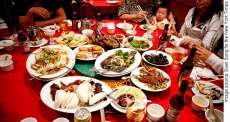 Observing the seating arrangement can be a useful way of understanding social relationships and hierarchies. Seating arrangements are less strict at informal gatherings.
Observing the seating arrangement can be a useful way of understanding social relationships and hierarchies. Seating arrangements are less strict at informal gatherings.
The Food
A formal Chinese banquet can involve many courses, with platters of food laid out on the Lazy Susan.
The Lazy Susan eliminates the need to pass the potatoes or ask for yams, but be sure to spin the Lazy Susan in the clockwise direction. If you notice fellow diners sitting with empty plates, it’s also polite to send the platters their way.
Meals typically begin with cold appetizers, such as pickled cucumbers, preserved eggs, cold slices of cooked meat, or sometimes the more exotic pickled jellyfish and duck tongue.
Western food is also gaining popularity in China, so don’t be surprised if you see a Chinese potato salad or Caesar salad.
Soup and small cakes may be served between courses as a palate cleanser, and there are typically many proteins as well as vegetarian dishes.
The main entrée, or zhŭ shí (主食) , such as rice, is usually the last course, and you might not want to eat too much of it, as it can signify to the host that you didn’t enjoy the rest of the meal. Fresh fruit is often brought out at the end, as a light dessert.
Fish and seafood are common banquet features, since the character for fish, yú (鱼) , sounds like the character for abundance, yú (余).
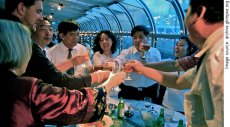
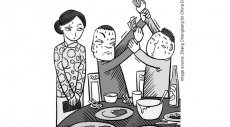
Related posts:

 Mirrors act as magicians in your home: They make spaces appear larger, multiply light, and duplicate views. Depending on their size and placement, they can play…
Mirrors act as magicians in your home: They make spaces appear larger, multiply light, and duplicate views. Depending on their size and placement, they can play… Layout for Small Rooms Strip/Basic Home Office Layout. C. Roseberry Create a Functional and Organized Workspace Tired of working in your home office because it s…
Layout for Small Rooms Strip/Basic Home Office Layout. C. Roseberry Create a Functional and Organized Workspace Tired of working in your home office because it s… This cozied-up formal dining room is wonderful for those who have a large family or group of friends and often find themselves throwing dinner parties or hosting…
This cozied-up formal dining room is wonderful for those who have a large family or group of friends and often find themselves throwing dinner parties or hosting… Will it work in the space I have planned? Our published dimensions (e.g. 93 Wx46 Dx32 H) width x depth x height in inches, will help you decide if your furniture…
Will it work in the space I have planned? Our published dimensions (e.g. 93 Wx46 Dx32 H) width x depth x height in inches, will help you decide if your furniture… Schlafzimmer: Ideen, von der Einrichtung bis zur Deko Überlegen Sie sich vor dem Einrichten die Anordnung Ihrer Schlafzimmermöbel. Ist der perfekte Standort für…
Schlafzimmer: Ideen, von der Einrichtung bis zur Deko Überlegen Sie sich vor dem Einrichten die Anordnung Ihrer Schlafzimmermöbel. Ist der perfekte Standort für…